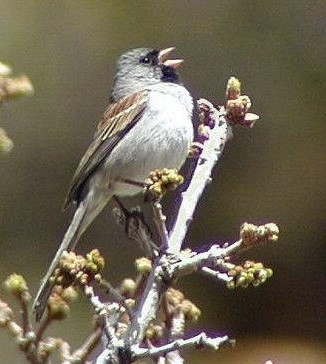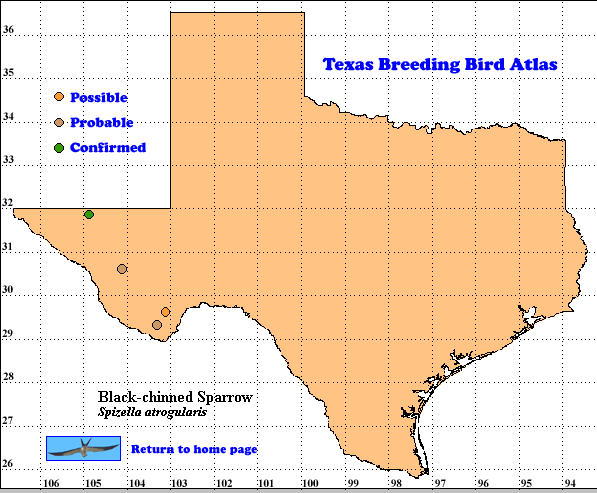The Black-chinned Sparrow is a shy inhabitant of brushy hillsides in the mountains of Trans- Pecos Texas during its breeding season. In winter the birds migrate south or down slope to warmer locations.
The species is best detected during the breeding season by the male’s distinctive song. Females and juveniles lack the male’s face pattern acquired just prior to the breeding season. Males revert to a less distinct “female- like” plumage during the fall molt.
The species has four recognized subspecies, three mostly migratory, breeding in the United States. A resident subspecies in central Mexico differs in size, plumage and molt pattern from the migratory subspecies (see Pyle [1997] and Tenney [1997] for more details).
Among Spizella sparrows the Black-chinned is most closely related to the Field Sparrow (S. pusilla) of eastern North America (Tenney 1997).
DISTRIBUTION., During the 1987-1991 TBBA project field work, observers found confirmed breeding evidence only in the Guadalupe Mountains of Trans-Pecos Texas and probable records in the Chisos and Davis, mountains. Oberholser (1974) reported these areas as breeding sites at elevations between 1650 and 2400 m (5500 – 8000 ft).
In other states Black-chinned Sparrows breed on the east side of the coastal mountains of California and southern Oregon and the foothills of the Sierra Nevada Mountains. The species also breeds in the desert ranges of southern California, Nevada, Arizona, New Mexico and southwestern Utah.. The breeding range extends into northern Baja California. In mainland Mexico the breeding range continues south to central Mexico. Many northern birds migrate south to winter in northern Mexico, and southern Baja California, southern Arizona and New Mexico.
SEASONAL OCCURRENCE. Black- chinned Sparrows appear to be present all year in the mountains of Trans-Texas (Tenney 1997). Oberholser (1974) suggests the breeding season is March to July. TBBA volunteers found a pair on or near a nest on April 17.
BREEDING HABITAT. Black-chinned Sparrows nest on brushy slopes in mountains or canyons. The compact cup is built in a bush, often well concealed, and constructed of grasses and plant stems, and lined with finer grasses, shredded fibers and sometimes animal hair. The outside diameter of the nest is 10 cm (4 in), height 7 cm (2.8 in), inside diameter 4.5 cm (1.8 in) and depth 3.5 cm (1.3 in). The female lays 3-4 (range 2-5) light greenish to blue eggs, which may be marked or lightly spotted. The female incubates the eggs for 12-13 days and broods the young, although both parents bring food. The length of the nestling period is unknown. Black-chinned Sparrow is a rare host of Brown-headed Cowbird (Molothrus ater; Oberholser 1974, Harrison 1979, Tenney 1997).
STATUS. Lockwood and Freeman (2004) report Black-chinned Sparrow to be an uncommon summer resident in the central mountains of Trans-Pecos Texas. In winter many individuals move to lower elevations such as the Franklin Mountains of El Paso County where the species is uncommon in winter and scarce in summer.
The North American Breeding Bird Survey (BBS) method only detects this species on 2 routes in Texas with an average of 1-3 Black-chinned Sparrows per route per year in Big Bend National Park and <1 in the remainder of the Trans-Pecos region. The information from these two routes supplies too little data for any trend estimate. The 56 BBS routes in the United States which encounter this species produce a statistically significant trend for the 1966-2003 period of -5.1% population change per year (Sauer et al. 2004). This disturbingly large number suggests the species has declined to about 16% of its 1966 level across its range north of the Mexican border. Text by Robert C. Tweit (2006)
Literature cited;
Harrison, H. H. 1979. A field guide to western birds’ nests. Houghton Mifflin, Boston, MA.
Lockwood, M. W. and B. Freeman. 2004. The TOS handbook of Texas birds. Texas A&M University Press, College Station.
Oberholser, H. C. 1974. The bird life of Texas. University of Texas Press, Austin.
Pyle, P. 1997. Identification guide to North American birds, part 1. Slate Creek Press, Bolinas, CA.
Sauer, J. R., J. E. Hines, and J. Fallon. 2004. The North American Breeding Bird Survey, results and analysis 1966-2003. Version 2004.1. USGS Patuxent Wildlife Research Center, Laurel MD (Web site, http://www.mbr-pwrc.usgs.gov/bbs).
Tenney, C. R. 1997. Black-chinned Sparrow (Spizella atrogularis). In The birds of North America, No. 270 (A. Poole and F. Gill, eds.). The Birds of North America, Inc., Philadelphia, PA

